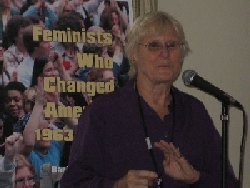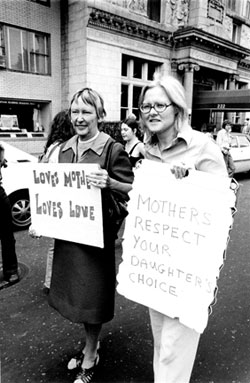BARBARA LOVE, FEMINIST of the MONTH -- OCTOBER 2009 FEMINIST AND GAY RIGHTS ACTIVIST, CHAMPION SWIMMER, JOURNALIST, FORCE BEHIND FEMINISTS WHO CHANGED AMERICA – 1963-1975 If Second Wave activists were graded according to their contributions, Barbara Love would be in the top ten. For more than 40 years she’s never wavered. When one door closed, she opened another–-and if there was no door to open, she’d cut one out of the wall of sexual bias and create a new venue to fight for women’s and gays’ rights .  So when does one realize that
one is a feminist, that one is different? For Barbara it was at a very early age. At home in Ridgewood, NJ, she
wondered why women had to be in the kitchen while men were in the living room discussing things of world import. So when does one realize that
one is a feminist, that one is different? For Barbara it was at a very early age. At home in Ridgewood, NJ, she
wondered why women had to be in the kitchen while men were in the living room discussing things of world import.She felt she was a disappointment to her mother, an important woman in town, important the way women could be in those pre-feminist years. Head of the Debutante Cotillion, president of the Women’s Club and other clubs, Lois Love hoped her daughter would follow in her footsteps and make her proud. "I thought the Cotillion stupid, degrading and a waste of money." Barbara admits. “Not only that, I hung out with the poorer kids, rather than the ‘club set’ and that was radical.” She felt she didn't "fit in" during her childhood, but her one joy was swimming. “When I was three years old,” she relates, “I had to swim across the pool with my five-year-year-old brother at an event at our country club. After that, I swam all summer, entered swim contests and won many NJ state championships. A headline in the New York Times lauded me with an article titled Love At Thirteen Is Good. Today at 72, Barbara swims in Master’s competitions, competing in the most demanding events. She often wins because, she explains, “I am the only one in my age group, so winning five gold medals isn’t so impressive, as most of the time I have no competition.” Barbara realized early she was gay. She remembers having a crush on her third grade teacher. In middle school she had crushes on girls, but never spoke about this (there was no one to talk to anyway). Later, as a journalism student at Syracuse University, she learned that lives of gays were sad and often perilous. Women were thrown out of college for being gay. After college she spent two years in Europe. In Italy she taught at an American school. On returning to the U.S. in 1961 she went to gay bars, which she found degrading. There was no gay movement and gays could be arrested for whatever reason. Barbara learned about NOW from radio host, Long John Nebel, whom she had interviewed as part of her job as a journalist. Nebel recommended she talk to a feminist friend of his, who introduced her to Muriel Fox, a NOW founder. Muriel sent her to Dolores Alexander, who had joined NOW after interviewing Betty Friedan for The Long Island Press. At the time NOW was only a national board and a small New York chapter, which met at Betty’s apartment in the Dakota building. Preparing for the first meeting, Dolores gave Barbara a recipe and told her to cook a chicken for the board of directors. She says, “ I couldn’t believe I’d joined the women’s movement to cook!” She found Betty harsh and demanding so kept her distance. But there was much activity in the chapter and a passionate group of young activists, including Kate Millett and Rita Mae Brown. There were demonstrations against Colgate-Palmolive, and the New York Times; against hotel and restaurant men-only dining rooms, some of which Barbara helped organize. In 1970, because she realized the importance of providing a resource on women by their abilities and professional accomplishments, she compiled, edited and published Foremost Women in Communications.  Meanwhile the lesbian cause was the main topic of conversation, and many “straights” were thrown off kilter. Some NOW members weren’t even aware that some of their closest cohorts in the movement were gay. Betty Friedan herself freaked out and began to portray the lesbian presence as damaging to NOW, which inspired Barbara to respond publicly. “My life had gotten better since I’d joined NOW and even better when I joined the women forging the beginnings of lesbian liberation,” she recalls. “I stayed with NOW to work with others to gain acceptance of lesbianism as a feminist issue.” Our efforts were successful in that at the national conference in California in 1971 NOW passed a resolution spearheaded by Arlie Scott proclaiming lesbianism a feminist issue. In 1976, at the historic International Women’s Year conference in Houston, Friedan publicly endorsed the resolution of lesbian rights. With Morty Manford, a leader of the Gay Activist’s Alliance, and their mothers, Barbara started Parents of Gays, today a nationwide organization. She says proudly, when in 1968 I finally had the courage to tell my mother I was gay, her response was ‘First to thine own self be true.’ She joined me in the 1970 Gay Pride march in New York." Barbara was also one of the founders of Identity House, a free walk-in center for gays and their families still active today.” (pictured right: Barbara Love and her mother at a Gay Rights March, June 29, 1974. Photograph by Cary Herz.) Nineteen-seventy-one saw the publication of Sappho Was a Right-on Woman, which she co-authored with Sidney Abbott. It was the first nonfiction book with a positive view of lesbianism and it is still in print. Though involved in her career as a writer/editor, for the next few years Barbara continued her behind-the-scenes activism. In 1998, inspired by the founding of VFA, which was organized to document the history of the Second Wave and honor all who made it happen, she began a monumental mission: to record the bios of the pioneers who led and made the revolution. Feminists Who Changed America 1963-1975, published by the University of Illinois Press, is a masterful work that belongs on the table of everyone involved in the Movement. Barbara credits VFA members who helped accomplish this reference work documenting the contributions of more than 2,200 feminists. She is now working on a next edition/supplement so as to include many who missed the first go-round. Not only is she still involved in collecting and writing up bios of pioneer feminists, but she often travels around the country to introduce the book at VFA and NOW events, which she sometimes helps plan. She’s been to Denver for one planned by Ellie Greenberg, to Los Angeles where Zoe Nicholson’s NOW chapter gave her an outstanding welcome. She starred at the 2007 VFA conference that introduced the book at Columbia and Barnard, and in March 2009 she and Eleanor Pam held a powerful event in Pompano Beach, Florida. She will consider going anywhere in the country to help you celebrate your local heroes. If you were active between 1963 and 1975 and are not in the book, contact Barbara at BJLove@msn.com and ask for a questionnaire. To buy FWCA, get a 20 percent discount by contacting the distribution center at 800-621-2736 and asking for the discount ($64 instead of $80) because Barbara Love told you it's available to feminists who ask for it. Comments to Jacqui Ceballos: jcvfa@aol.com Back to VFA Fabulous Feminists Table of Contents |